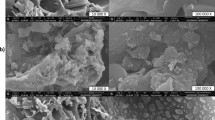Abstract
Polyvinyl alcohol borate hydrogel was used due to its ability to absorb cations to remove excess cations of salinity and sodium from a number of soil samples collected from district 7 of Gonbadkavus city. The experimental data were obtained by measuring electrical conductivity, pH and the amount of sodium, potassium, magnesium and calcium ions of saturated soil extract using flame photometer and titration method at each stage of mixing hydrogel with soil. After obtaining the value of the sodium absorption ratio and exchangeable sodium percentage, it was found that these values decrease after each modification step. In the final modification stage, the soil becomes non-saline but remains sodic, and the reason for this fact is that its sodium cation content is much higher compared to other cations; hence, further modification steps are suggested to reduce the sodium content of the soil before its use for agricultural purposes. At the end, a table has been prepared which is used to compare the tolerable salinity of the seeds of different plants before and after modification.







Similar content being viewed by others
Data availability
All the data are in the main text of paper.
References
Abdeena ZU, Saeeda R (2019) Soil desalination via poly(vinyl alcohol) borate hydrogel. Theor Found Chem Eng 53(6):1094–1098
Abolqasem HE (2017a) A look at salt and saline soils. Organization of Agricultural Engineering System of the country, publication number 2
Abolqasem HE (2017b) Irrigation water quality and soil salinity. Organization of agricultural engineering system and natural resources of the country, publication number 1
Allison LE (1954) Diagnosis and improvement of saline and alkali soils. USDA Agricultural Handbook, US Salinity Laboratory Staff No. 60. Washington, DC: U.S. Government Printing Office
Chartzoulakis KS, Loupassaki MH (1997) Effects of NaCl salinity on germination, growth, gas exchange and yield of green house egg plant. Agric Water Manag 32:215
Das D, Prakash P, Rout PK, Bhaladhare S (2021) Synthesis and characterization of superabsorbent cellulose-based hydrogel for agriculture application. Starch 73:1900284
Hasanuzzaman M, Nahar K, Alam M et al (2023) Potential use of halophytes to remediate saline soils. BioMed Res Int 2:589341
Hasegawa PM, Bressan RA, Handa AK (1986) Cellular mechanism of salinity tolerance. HortScience 21:1317–1324
Hogg TJ, Henry JL (1984) Comparison of 1:1 and 1:2 suspensions and extracts with the saturation extract in estimating salinity in Saskatchewan soils. Can J Soil Sci 64:699
Katerji N, Van Hoorn JW, Hamdy A, Mastrorilli M (2003) Salinity effect on crop development and yield, analysis of salt tolerance according to several classification methods. Agric Water Manag 62(1):37
Kibblewhite MG, Ritz K, Swift MJ (2008) Soil health in agricultural systems. Philos Trans R Soc B 363:685
Maghchiche A, Haouam A, Immirzi B (2010) Use of polymers and biopolymers for water retaining and soil stabilization in arid and semiarid regions. J Taibah Univ Sci 4:9–16
Ramagopal S (1987) Salinity stress induced tissue-specific proteins in barley seedlings. Plant Physiol 84:324
Shirokova Y, Forkutsa I, Sharafutdinova N (2000) Use of electrical conductivity instead of soluble salts for soil salinity monitoring in Central Asia. Irrigat Drainage Syst 14:199
Sonon LS, Saha U, Kissel DE (2012) Soil salinity: testing, data interpretation and recommendations, UGA cooperative extension circular 1019. Univ. of Georgia, Athens
Suriyan C, Chalermpol K (2011) Remediation of salt-affected soil by the addition of organic matter—an investigation into improving glutinous rice productivity. Sci Agric 68(4):406–410
Tamadoni A, Qaderi F (2019) Optimization of soil remediation by ozonation for PAHs contaminated soils. Ozone Sci Eng 41(5):454–472. https://doi.org/10.1080/01919512.2019.1615865
Tavakkoli E, Rengasamy P, McDonald GK (2010) The response of barley to salinity stress differs between hydroponic and soil systems. Funct Plant Biol 37:621
Tefera BB, Bayabil HK, Tong Z, Teshome FT, Wenbo P, Li YC, Hailegnaw NS, Gao B (2022) Using liquefied biomass hydrogel to mitigate salinity in salt-affected soils. Chemosphere 309:136480
Wang Y, Zhang GJ, Wang B, Yu L (2022) Contrasting influences of biogeophysical and biogeochemical impacts of historical land use on global economic inequality. Nat Commun 13:2479
Funding
This research did not receive any specific grant from funding agencies in the public, commercial, or not-for-profit sectors.
Author information
Authors and Affiliations
Contributions
In this article, all work was done by Mehran Taneh Gonbadi and Dr. Qaderi. This work was done in the laboratory of Babol Noshirvani University of technology and all expenses and raw materials were prepared by the Dr Qaderi and Mehran Taneh Gonbadi.
Corresponding author
Ethics declarations
Competing interests
The authors have not disclosed any competing interests.
Additional information
Publisher's Note
Springer Nature remains neutral with regard to jurisdictional claims in published maps and institutional affiliations.
Rights and permissions
Springer Nature or its licensor (e.g. a society or other partner) holds exclusive rights to this article under a publishing agreement with the author(s) or other rightsholder(s); author self-archiving of the accepted manuscript version of this article is solely governed by the terms of such publishing agreement and applicable law.
About this article
Cite this article
Tanehgonbadi, M., Qaderi, F. Investigation of the effect of initial composition of soil on the efficiency of desalination by polyvinyl alcohol borate hydrogel. Environ Earth Sci 82, 340 (2023). https://doi.org/10.1007/s12665-023-11009-8
Received:
Accepted:
Published:
DOI: https://doi.org/10.1007/s12665-023-11009-8




